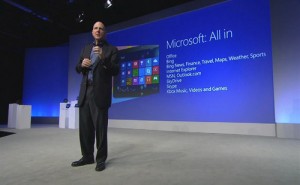 Windows 8 is finally here and the stakes are sky high for Microsoft.
Windows 8 is finally here and the stakes are sky high for Microsoft.
“We’re so happy to be here today and to celebrate the global availability of a new era of Windows and Windows-powered PCs,” said Steven Sinofsky, president of Microsoft’s Windows and Windows Live Division, at the launch event in New York. “There is so much excitement and potential for the future of computing to improve how we work, learn and entertain. Windows 8 is a major milestone in the evolution and revolution of computing.”
With Windows 7 and prior versions of the OS used by more than 1 billion people, Windows 8 begins a new era of computing “for the next billion people” in a market changed by the rise of tablets and mobility, he said. Microsoft has reimagined the OS for this new reality, he added.
“The clunky desktop PC has been replaced by more sleek, more powerful, more mobile PCs with vastly more storage and computing [power] at a fraction of the price,” he said.
So far, more than 1,000 tablets and PCs featuring a wide variety of screen sizes, configurations, form factors and designs have been certified for Windows 8, he said. “Fully capable” Windows 8 PCs will be available for under US$300, he said.
Sinofsky also announced the availability of Windows 8 upgrade offers in retail stores and online, as well as the official launch of the online Windows Store, where customers can find new Windows 8 applications built with the new Windows runtime WinRT APIs and tools.
Once the supreme leader of personal computing, Microsoft faces a brave new world in which PCs are losing territory to tablets and smartphones, in which Windows has a minor presence.
Since Windows 7 came out in 2009, the world has caught tablet fever. So, Microsoft designed Windows 8 primarily to help the company make a run at the tablet market. Windows Phone 8, expected to be launched next week, is supposed to do likewise in the smartphone market.
Windows is still the dominant PC OS, but PC sales have shrunk. In the third quarter, worldwide unit shipments dropped 8.6 percent year-on-year, a “severe slump” due in part to “pressure” from tablets and smartphones, according to IDC.
Meanwhile, tablets are flying off the shelves. Gartner forecasts worldwide media tablet sales to end users to total 119 million units in 2012, up 98 percent compared with 2011. Gartner expects Apple’s iOS to continue its dominance with a projected share of over 61 percent. Windows is expected to ship in only 4.8 million tablets this year.
Making Microsoft’s position worse is the BYOD (bring your own device) trend, in which millions of people worldwide now use their personal smartphones and tablets at work. Android phones, iPads and iPhones have invaded workplaces while Microsoft hasn’t been able to counterpunch.
In a recent study, Forrester Research predicted that by 2016, Windows will remain the leader in desktop and laptop OSes, be a contender in tablets with about 27 percent of unit sales and trail Android and iOS in the smartphone market with only 14 percent of units.
At least publicly, Microsoft has expressed complete confidence that Windows 8 will succeed. It has spent more than a year trying to create excitement around the product among developers, OEMs, ISVs, consumers and enterprises.
However, key questions remain.
The new tile-based Windows user interface, formerly called Metro, is a radical redesign meant to optimise the OS for tablets with touchscreens and stylus pens. Windows 8 is also designed to work on desktops and laptops using keyboards and mice.
It is possible to toggle between this new interface and a more traditional Windows desktop in Windows 8. However, some observers are skeptical, saying that the new interface could be a deal-breaker for consumers and enterprise buyers who find it too different, and thus counterproductive and inconvenient.
There is also skepticism around enterprise adoption, primarily because a majority of companies have either recently finished migrating to Windows 7 from Windows XP, or are in the process of doing so.
As of May of this year, Gartner had estimated that in developed countries, Windows 7 had been fully implemented in about 10 percent of enterprises, while 55 percent were in the process of deploying it and 25 percent were just starting.
Since enterprises typically let several years pass between corporate desktop refreshes, many industry observers are predicting that many IT departments will not consider upgrading to Windows 8 until 2014 at best. Some may bypass Windows 8 altogether.
Microsoft has been trying to strike a delicate balance between promoting Windows 8 without discouraging enterprises from upgrading to Windows 7 from XP.
In pitching Windows 8 to enterprises, Microsoft is focusing on its optimisation for tablet devices and on the opportunity for IT departments to standardise on a centrally managed fleet of Windows tablets, as opposed to a heterogeneous, BYOD approach.
This may be a compelling message. A recent survey of 100 U.S. IT managers found that almost half of them plan to standardise their company’s mobile platform on Windows devices. That compares with 8 percent for Google’s Android OS and 14 percent for Apple’s iOS, according to the survey, conducted by ThinkEquity, a financial research and services firm.
Microsoft is also highlighting enterprise features like Windows To Go, which lets users boot and run Windows 8 from USB devices such as flash drives, desktop virtualisation improvements and new security capabilities.
Questions have also been raised about the Windows 8 version for ARM devices called Windows RT,which has significant differences with the main Windows 8 version for x86/64 chips from Intel and AMD.
Windows RT also launched Thursday, but it will only be available pre-installed on devices, which will be based on system-on-a-chip hardware platforms from ARM licensees Nvidia, Qualcomm and Texas Instruments. The idea is that these Windows RT devices, compared with Windows 8 tablets, will generally be lighter and thinner, with longer battery lives and lower prices, and thus fulfill different needs.
Most significantly, Windows RT devices will not run existing Windows 7, Vista and XP applications, but rather only new ones created with the new Windows runtime WinRT APIs. Windows RT devices will only be able to install applications from the new online Windows Store, which on the day prior to the Windows 8 launch only had several thousand applications. In fact, browser makers Google and Mozilla have complained that only Internet Explorer 10 will have full access to Windows RT system resources. Windows 8 PCs and tablets will not face these architectural restrictions.
One element potential buyers may find compelling is that Windows RT devices will include a version of the new Office edition at no extra cost called Office Home & Student 2013 RT. It will include Word, Excel, PowerPoint and OneNote, and will provide what Microsoft calls “a complete Office experience.” However, in what could turn off enterprises, this Office version isn’t licensed for business use, requiring that organisations purchase commercial use rights or own a commercial license to Office 2013 suites. Windows RT also lacks several IT management features that Windows 8 does have.
Microsoft plans to make its own Microsoft-branded tablets called Surface. There will be one for Windows RT and another one for Windows 8.
Attempting to address another area where it is perceived to be lagging, Microsoft designed Windows 8 to be tightly integrated with SkyDrive. Microsoft’s goal is to make the cloud storage service a “single drive” available across all the devices people use, giving them “instant, secure and private access to their files” and letting them share those files with others.
As of Friday, when Windows 8 and Windows RT begin to ship, their fate — and Microsoft’s — is in the hands of consumers and enterprises.





